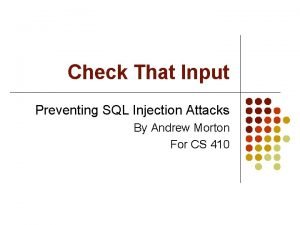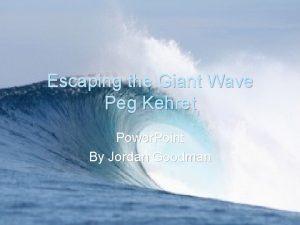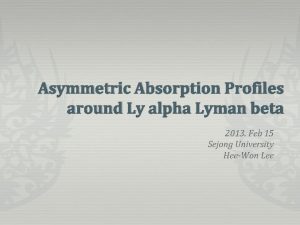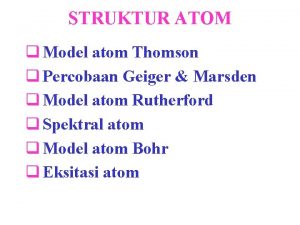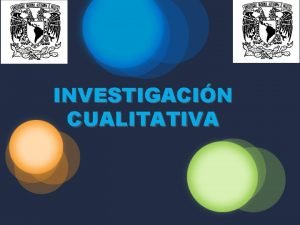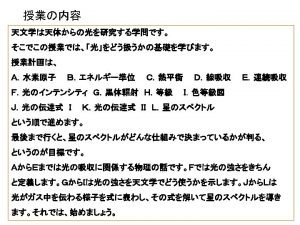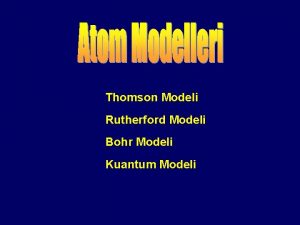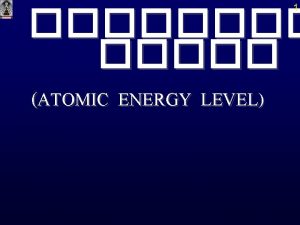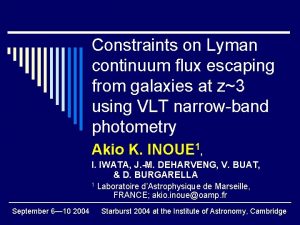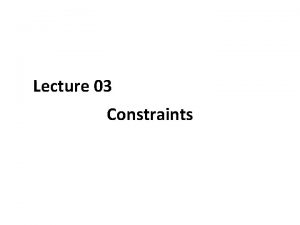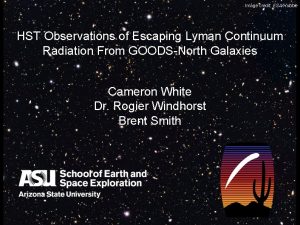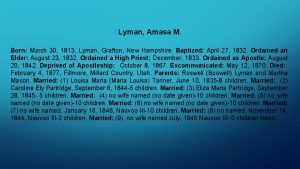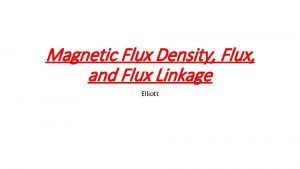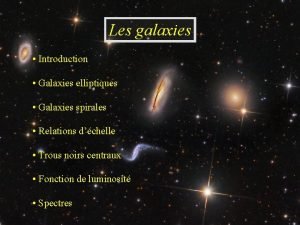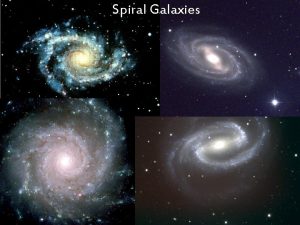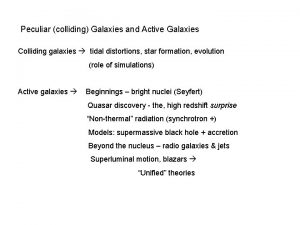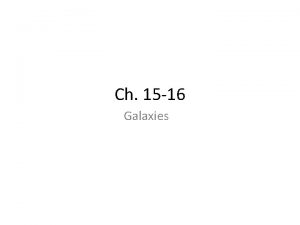Constraints on Lyman continuum flux escaping from galaxies













- Slides: 13

Constraints on Lyman continuum flux escaping from galaxies at z~3 using VLT narrow-band photometry Akio K. INOUE 1, I. IWATA, J. -M. DEHARVENG, V. BUAT, & D. BURGARELLA 1 September 6— 10 2004 Laboratoire d’Astrophysique de Marseille, FRANCE; akio. inoue@oamp. fr Starburst 2004 at the Institute of Astronomy, Cambridge

Ionization history of the universe n Cosmic reionization epoch ¡ ¡ n How to proceed? ¡ ¡ n End at z~6 (Becker et al. 2001) Start at z~17 (Kogut et al. 2003) What is the main ionizing source; galaxies (stars) or others? Can the ionizing photons escape from galaxies efficiently? We will discuss the escape of Lyman continuum from galaxies. September 6— 10 2004 Starburst 2004 at the Institute of Astronomy, Cambridge

Lyman continuum escape n n Steidel et al. (2001) succeeded in detecting the Lyman continuum photons from galaxies at z~3, whereas all the other attempts could not detect. Spectroscopy was always adopted in the attempts, except for Malkan et al. (2003) who performed a broad-band photometry for z~1 galaxies and succeeded in obtaining the most strict upper limits on the escape fraction of Lyman continuum. September 6— 10 2004 Lyman limit Steidel et al. (2001): the composite spectrum of 29 Lyman break galaxies at z~3. 4. Starburst 2004 at the Institute of Astronomy, Cambridge

Our approach n Narrow-band photometry ¡ close to the Lyman limit (smaller IGM opacity) n ¡ ¡ very important for high-z galaxies moderate sensitivity (better than spectroscopy) select galaxies with an appropriate redshift to avoid any contamination of light above the Lyman limit. Lya n The redshift criterion for the OII+44 filter of VLT/FORS is z~3. 2. September 6— 10 2004 Lyman limit (z=3. 2) Starburst 2004 at the Institute of Astronomy, Cambridge

Observations n n n After the pre-selection of galaxies in the HDFSouth based on the photometric redshift catalog of Labbé et al. (2003), we performed the spectroscopy with the VLT/FORS 2 to know the accurate redshifts. Because of unexpected systematic errors of the photometric redshifts, only two galaxies with an appropriate redshift were left in our sample. We spent ~11 h exposure (on-source) toward the HDFS field through the narrow-band, OII+44 (central wavelength ~372 nm), filter with the VLT/FORS 1. September 6— 10 2004 Starburst 2004 at the Institute of Astronomy, Cambridge

Observational results HDFS 85 1825 zsp 3. 170 3. 275 OII+44 <27. 4 <26. 6 U 300 <67. 8 <28. 1 B 450 392 182 V 606 699 405 I 814 860 504 HDFS 1825 Unit of the photometric data is n. Jy. ID of galaxies and U, B, V, I photometric data are taken from Casertano et al. (2000). Upper limits are 2 -s. September 6— 10 2004 Starburst 2004 at the Institute of Astronomy, Cambridge

Definition of escape fractions n Absolute escape fraction: : intrinsic Lyman continuum (LC) flux : LC flux just outside of the galaxy n Relative escape fraction: : intrinsic UV flux, : UV flux just outside of the galaxy observed LC flux: observed UV flux: NOTE 1: UV wavelength is set to be longer than Lya to be free from the IGM opacity. NOTE 2: fesc, rel is not restricted to less than unity. September 6— 10 2004 Starburst 2004 at the Institute of Astronomy, Cambridge

Comparison of the data at z~3 galaxies zsp (FUV/FLC)obs t. LCIGM fesc, rel ref. HDFS 85 HDFS 1825 3. 170 3. 275 >24. 4 >14. 6 1. 32 1. 99 <0. 46 <1. 5 a a LBG composite 3. 40 17. 7 1. 50 0. 76 b DSF 2237+116 C 2 3. 319 >37 1. 41 <0. 33 c Q 0000 -263 D 6 2. 961 >35 1. 04 <0. 24 c FLY 99: 957 3. 367 >3. 5 4. 63 . . . d FLY 99: 825 3. 369 >18 4. 64 . . . d FLY 99: 824 3. 430 >12 4. 94 . . . d a: this work, narrow-band (OII+44) photometry; b: Steidel et al. (2001), spectroscopy; c: Giallongo et al. (2002), spectroscopy; d: broad-band (U 300) photometry. NOTE 1: (FUV/FLC)int is given by a population synthesis model to calculate fesc, rel. NOTE 2: t. IGM is calculated by a model of the mean IGM opacity. September 6— 10 2004 Starburst 2004 at the Institute of Astronomy, Cambridge

Advantages of our approach n Narrow-band photometry can put the most strict constraint on the relative escape fraction for normal LBGs. ¡ ¡ ¡ For individual galaxies, we have reached a similar level of FUV/FLC to the composite spectrum of 29 LBGs by Steidel et al. Higher sensitivity of the broad-band U are lost by heavier IGM absorption because the effective wavelength in the source rest-frame is as short as ~700 A. Giallongo’s LBGs are ~4 times brighter than ours and Steidel’s. September 6— 10 2004 Starburst 2004 at the Institute of Astronomy, Cambridge

To estimate absolute escape fraction n Absolute escape fraction is ¡ ¡ FLCint and t. LCIGM can be estimated by a multicolor SED fitting. “Physically” based SED fitting method: n n NOT just a c 2 fitting. ISM dust and IGM absorption amounts, age, and SFR can be estimated from B, V, I, K data, assuming dust attenuation law (e. g. Calzetti’s law), IGM cloud number distribution (only functional shape), metallicity (e. g. 40% of solar), and constant star formation history. September 6— 10 2004 Starburst 2004 at the Institute of Astronomy, Cambridge

IGM absorption Physically based SED fitting n n n V-I B-I red: Solar, blue: 1/5 Solar, green: 1/20 Solar metallicity dust attenuation A unique solution in (t. ISM, t. IGM) can be found from observed B-I and V-I because the significance of the IGM absorption is different between B and V. However, to do that, we have to know the intrinsic spectrum which depends on SFH and metallicity. Assuming a constant SFR, I-K is a good indicator of the age. Metallicity effect is secondary. September 6— 10 2004 Starburst 2004 at the Institute of Astronomy, Cambridge

Fitting results H I B V K V J H I B K J U U OII+44 HDFS FOIIobs 85 <27. 4 1825 <26. 5 FOIIint 752 393 t. OIIIGM 1. 2 1. 6 fesc <0. 12 <0. 35 Unit of flux density is n. Jy and upper limits are 2 -s. NOTE: t. IGM relative to a mean one is estimated by the fitting. September 6— 10 2004 Starburst 2004 at the Institute of Astronomy, Cambridge

Conclusions n n We did not find any significant escape of Lyman continuum from two Lyman break galaxies (LBGs) at z~3 through the narrow-band photometry with VLT. The two LBGs have a small absolute escape fraction, less than 10— 30%. For the moment, the sample size is too small to conclude that many LBGs have a small escape of Lyman continuum. Narrow-band photometry can put a stronger constraint on the escape fraction of individual normal LBGs than spectroscopy and broad-band photometry. September 6— 10 2004 Starburst 2004 at the Institute of Astronomy, Cambridge




